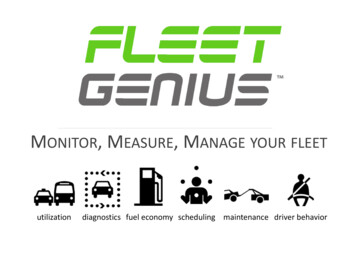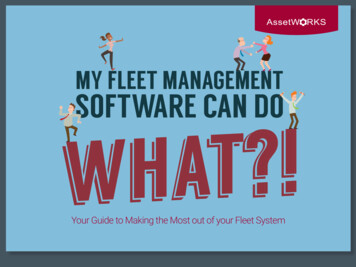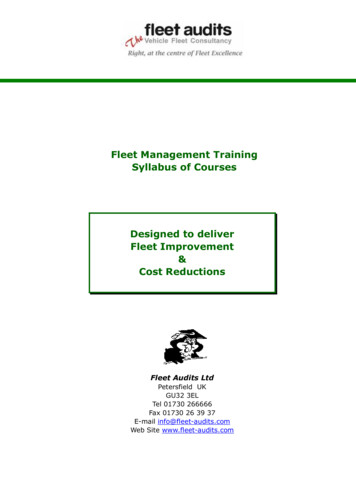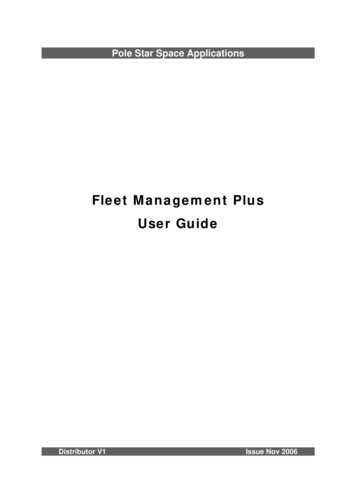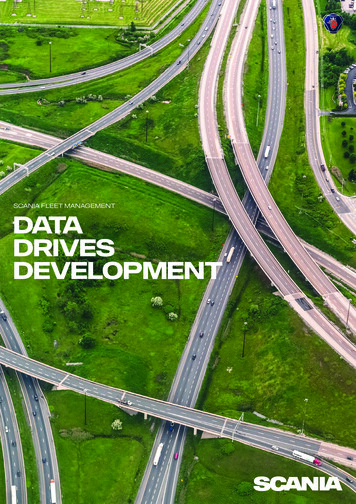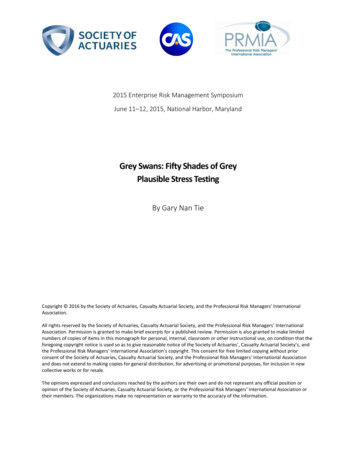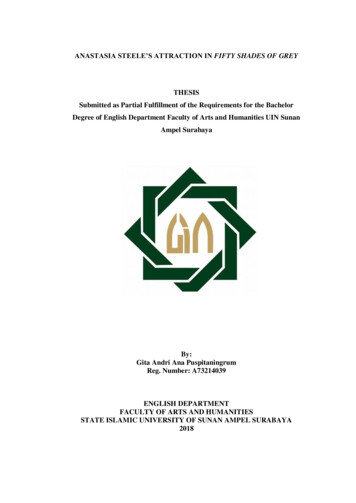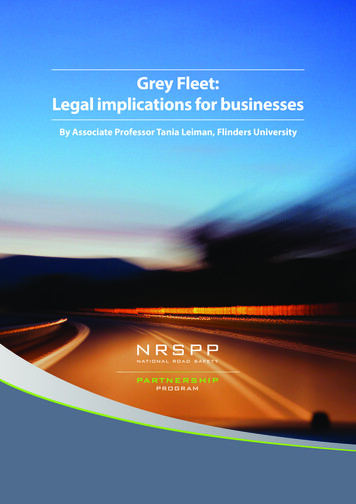
Transcription
Grey Fleet:Legal implications for businessesBy Associate Professor Tania Leiman, Flinders University
I wish to acknowledge the considerable assistance providedto me by research assistants Alana Humphris and AnthonyStoks, both LLBL(Hons) at Flinders University, and thank themfor their work.
1.Executive Summary Unlike the UK, the law relating to grey fleets is as yet undeveloped inAustralia. The term ‘grey fleet ‘ is not specifically included in any Australian legislationor case law. Legal liability imposed on employers for use of these grey fleet vehicleswill be dependent on jurisdiction, legal context and the wording of specificlegislative provisions, and may differ across jurisdictions and contexts. Legislative regimes are often not consistent across all Australian states andterritories, and limited case law exists regarding grey fleet issues For work health & safety purposes, ‘workplace’ includes a vehicle used by aworker for work purposes Employers have legislative duties to ensure, so far as is reasonablypracticable, the health and safety of their workers and other persons At common law, employers must also take reasonable care not to cause harmto those persons to whom they owe a duty What is reasonably practicable and/or what amounts in law to takingreasonable care will depend on the individual circumstances of each caseand is determined retrospectively by a court. The legislative definitions of ‘reasonably practicable’ and ‘reasonableprecautions’ can provide a general guide for prospectively assessing the risksof harm associated with using grey fleet vehicles.1NRSPP - National Road Safety Partnership Program
2. Scope of ProjectI have been asked by the National Road Safety Partnership Program (NRSPP),delivered by the Australian Road Research Board (ARRB), to provide a research reportas follows: Explore case law surrounding the liability and legal risk relating to the use ofgrey fleet by organisations Provide a series of hypotheticals which are underpinned by research andcaselaw as to what are the risks and exposure to organisations with regardsto grey fleet2.1 Limitations of reportThis research report does not undertake any review of the rights of action andrecovery in workers compensation legislation for liability for motor vehicle damagesarising out of the use of a motor vehicle, nor any review of interacting obligationsbetween workers compensation insurers and compulsory third party insurers inrelation to personal injury or death caused by motor vehicle accidents. This researchreport does not canvas the taxation implications of use of grey fleet, or the taxationimplications of characterising workers as employees or independent contractors.2.2 DisclaimerThe information contained in this research report is of a general nature and it notintended to be the provision of specific legal or professional services advice.Grey Fleet: Legal implications for businesses2
3. Key terms3.1 ‘Worker’ and/or ‘Employee’The definition of ‘worker’ varies depending on jurisdiction, legal context, andlegislative drafting, and ‘worker’ does not necessarily have the same meaning as‘employee’. As will be explored in more detail below, ‘worker’ is defined expansively inthe uniform Australian Work Health & Safety Acts, covering not only employees, but inadditional other roles as follows:(1) A person is a “worker” if the person carries out work in any capacity for a personconducting a business or undertaking, including work as—(a) an employee; or(b) a contractor or subcontractor; or(c) an employee of a contractor or subcontractor; or(d) an employee of a labour hire company who has been assigned to work inthe person’s business or undertaking; or(e) an outworker; or(f) an apprentice or trainee; or(g) a student gaining work experience; or(h) a volunteer; or(i) a person of a prescribed class.1For example, in SA, ‘worker’ for the purposes of workers compensation means(a) a person by whom work is done under a contract of service (whether or notas an employee);(b) a person who is a worker by virtue of Schedule 1(c) a self-employed worker, and includes a former worker and the legalpersonal representative of a deceased worker;2and ‘contract of service’ means(a) a contract under which 1 person (the worker) is employed by another(the employer); or(b) a contract, arrangement or understanding under which 1 person (the worker)works for another in prescribed work or work of a prescribed class; or(c) a contract of apprenticeship; or(d) a contract, arrangement or understanding under which a person(the worker)—(i) receives on-the-job training in a trade or vocation from another(the employer); and(ii is during the period of that training remunerated by the employer.3Work Health & Safety Act 2011 (Cth) s.7Return to Work Act 2014 (SA) s.153Return to Work Act 2014 (SA) s.4123NRSPP - National Road Safety Partnership Program
In other legal contexts, however, the distinction between employees and othertypes of workers such as independent contractors remains a critical one, and can bedeterminative of eligibility to access entitlements. Examples include prohibitionsagains sham contracting arrangements in the Fair Work Act4 and impositionat common law of vicarious liability on employers for the tortious acts of theiremployees but not of independent contractors.53.2 ‘Workplace’As will be explored in more detail below, for the purposes of the uniform Work Health& Safety Acts, a ‘workplace’ is a place where work is carried out for a business orundertaking and includes any place where a worker goes, or is likely to be, while atwork’ and includes a ‘vehicle’.63.3 Grey FleetGrey fleet has usefully been defined as ‘vehicles being used by a business that itdoesn’t own; vehicles owned and used by employees to conduct business andvehicles that are hired occasionally and used for business purposes.’7 This definitioncan be expanded beyond employees to workers more generally.The term grey fleet is relatively new in Australia, but ‘can be traced to the UK where ithas been used for the last 10-15 years’.8Fair Work Act 2009 (Cth) ss.357-359Hollis v Vabu [2001] HCA 44; Sweeney v Boylan Nominees [2006] HCA 196Work Health & Safety Act 2011 (Cth) s.8; Work Health & Safety Act 2011 (ACT) s.8; Work Health & SafetyAct 2011 (NSW) s. 8; Work Health & Safety (National Uniform Legislation) Act 2011 (NT) s.8; Work Health &Safety Act 2011 (Qld); Work Health & Safety Act 2012 (SA) s.8; Work Health & Safety Act 2011 (Tas) s.87Caroline Falls, ‘Ground breaking grey fleet survey highlights the risk to organisations’, Fleet News 21October 2016 Grey Fleet Special Report, Fleet Auto News, fleetautonews.com.au at page 235Grey Fleet: Legal implications for businesses4
4. Grey Fleet in the UK and EUThe significance of grey fleet for employers in the UK grew significantly followingthe passage of the Corporate Manslaughter and Corporate Homicide Act 2007 whichprovides:1 The offence(1) An organisation to which this section applies is guilty of an offence if the wayin which its activities are managed or organised—(a) causes a person’s death, and(b) amounts to a gross breach of a relevant duty of care owed by theorganisation to the deceased.(2) The organisations to which this section applies are—(a) a corporation;(b) a department or other body listed in Schedule 1;(c) a police force;(d) a partnership, or a trade union or employers’ association, that is anemployer.(3) An organisation is guilty of an offence under this section only if the way in whichits activities are managed or organised by its senior management is a substantialelement in the breach referred to in subsection (1). (6) An organisation that is guilty of corporate manslaughter or corporate homicide isliable on conviction on indictment to a fine.2 Meaning of “relevant duty of care”(1) A “relevant duty of care”, in relation to an organisation, means any of thefollowing duties owed by it under the law of negligence—(a) a duty owed to its employees or to other persons working for theorganisation or performing services for it;(b) a duty owed as occupier of premises;(c) a duty owed in connection with—(i) the supply by the organisation of goods or services(whether for consideration or not),(ii) the carrying on by the organisation of any construction ormaintenance operations,(iii) the carrying on by the organisation of any other activity on acommercial basis, or(iv) the use or keeping by the organisation of any plant, vehicle orother thing;(d) a duty owed to a person who, by reason of being a person withinsubsection (2), is someone for whose safety the organisation is responsible.5NRSPP - National Road Safety Partnership Program
The specific reference in s.2(1)( c)(iv) the UK Act to ‘a duty in connection with the useor keeping by the organisation of any vehicle ’ imposes a very clear duty on anyorganisation that ‘manage[s] or organise[s]’9 their activities to incorporate the use ofgrey fleet by employees.Following the passage of this UK legislation, the UK’s Department of Transportpublished ‘A Guide to Managing the Grey Fleet’ which included the business casefor managing the grey fleet, guidance for policy development and policy formation,suggestions re communicating the policy within the workplace, how to check a UK/EC/EEA driving licence, and a template grey fleet policy declaration. It also includeslinks to other relevant resources, such as the UK’s joint Health & Safety Executive andDepartment of Transport 2014 publication ‘Driving at work’ which also covers workrelated road safety.10In October 2016, the European Transport Safety Council [ETSC] also published itsown guide ‘Managing Grey Fleet Safety: A short guide for companies whose staffdrive their own cars for work’.11 It contains a number of very practical and accessiblerecommendations for employers to identify possible alternatives, minimise andmanage risks. The ETSC guide cites the following data from the UK: ‘40% of work vehicles are grey fleet; 14 million grey fleet vehicles are in use; 9 million vehicles are used for business journeys on a regular basis; 62% of private car use is for work-related activity’12Corporate Manslaughter and Corporate Homicide Act 2007 UK p://etsc.eu/wp-content/uploads/Grey fleet safety final.pdf12http://etsc.eu/wp-content/uploads/Grey fleet safety final.pdf page 5.m910Grey Fleet: Legal implications for businesses6
5. Grey Fleet in AustraliaWhile the UK and EU resources referred to above can provide significant assistance ingrey fleet management to persons conducting business in Australia, it is importantto acknowledge that those resources have been drafted in the context of differentlegislative regimes.It is also not clear whether grey fleet use in Australia is comparable per capita to thatin the UK.However, Safe Work Australia statistics regarding work-related traumatic injuryfatalities show that ‘[o]ver the period from 2003 to 2015, 65% of worker fatalitiesinvolved vehicles, of which over 40% were due to a vehicle collision on a publicroad’.13‘The report includes everyone killed: while working including unpaid volunteers and family workers, carryingout work experience, and defence force personnel killed within Australianterritories or territorial waters or travelling for work (worker fatalities) as a result of someone else’s work activity (bystander fatalities).’146. Grey Fleet in Australian lawSome Australian resources prepared by and aimed at businesses and fleet managersare freely available on line. 15This research has not been able to locate reference to the term ‘grey fleet’ inany Australian legislation. However, a variety of legislative schemes governresponsibilities of employers and employees in relation to the use of vehiclesduring work. These include work health & safety legislation, workers compensationlegislation, motor vehicle and driver licensing legislation.In addition, common law principles in relation to negligence and vicarious liabilitymay also be relevant.This research has not been able to locate reference to the term ‘grey fleet’ in anyAustralian case atistics15See for example: -a-Fleet-Policy.pdf ; https://afmanews.com.au/feature-going-grey/; Grey Fleet Special Report, Fleet Auto News, fleetautonews.com.au13147NRSPP - National Road Safety Partnership Program
7. Work Health & Safety Legislation7.1 ‘Workplace’ includes ‘vehicle’For the purposes of the Work Health & Safety Acts, (uniform across theCommonwealth, ACT, NSW, NT, Qld, SA, Tas jurisdictions) a ‘workplace’ is a placewhere work is carried out for a business or undertaking and includes any place wherea worker goes, or is likely to be, while at work’ and includes a ‘vehicle’.16In Victoria, “ ‘workplace’ means a place, whether or not in a building or structure,where employees or self‑employed persons work’ and ‘“place” includes a car, truck and any other vehicle’.17In Western Australia, ‘workplace means a place, whether or not in an vehicle,building, or other structure, where employees or self-employed persons work or arelikely to be in the course of their work.’18It is clear therefore that in all Australian jurisdictions, if work is carried out using avehicle, then work health and safety obligations are imposed on employers andpersons conducting a business or undertaking.7.2 Duties to workers‘Worker’ is defined very broadly in the uniform Work Health & Safety Acts 19 andincludes contractors or subcontractors and their employees, employees of labourhire companies, and outworkers.Section 19 of the uniform Work Health & Safety Acts imposes a primary duty of care on‘a person conducting a business or undertaking:’20(1) A person conducting a business or undertaking must ensure, so far as isreasonably practicable, the health and safety of:(a) workers engaged, or caused to be engaged by the person; and(b) workers whose activities in carrying out work are influenced or directed bythe person; while the workers are at work in the business or undertaking.(2) A person conducting a business or undertaking must ensure, so far as isreasonably practicable, that the health and safety of other persons is not put atrisk from work carried out as part of the conduct of the business or undertaking.(3) Without limiting subsections (1) and (2), a person conducting a business orundertaking must ensure, so far as is reasonably practicable:(a) the provision and maintenance of a work environment without risks to health andsafety; and(b) the provision and maintenance of safe plant and structures; andWork Health & Safety Act 2011 (Cth) s.8; Work Health & Safety Act 2011 (ACT) s.8; Work Health & SafetyAct 2011 (NSW) s. 8; Work Health & Safety (National Uniform Legislation) Act 2011 (NT) s.8; Work Health &Safety Act 2011 (Qld) Work Health & Safety Act 2012 (SA) s.8; Work Health & Safety Act 2011 (Tas) s.817Occupational Health and Safety Act 2004 (Vic) s. 5.18Occupational Health and Safety Act 1984 (WA) s. 319Work Health & Safety Act 2011 (Cth) s.720Work Health & Safety Act 2011 (Cth) s.19; Work Health & Safety Act 2011 (ACT) s.19; Work Health & SafetyAct 2011 (NSW) s. 19; Work Health & Safety (National Uniform Legislation) Act 2011 (NT) s.19; Work Health& Safety Act 2011 (Qld) Work Health & Safety Act 2012 (SA) s.19; Work Health & Safety Act 2011 (Tas) s.1916Grey Fleet: Legal implications for businesses8
(c) the provision and maintenance of safe systems of work; and(d) the safe use, handling and storage of plant, structures and substances; and(e) the provision of adequate facilities for the welfare at work of workers incarrying out work for the business or undertaking, including ensuringaccess to those facilities; and(f) the provision of any information, training, instruction or supervision thatis necessary to protect all persons from risks to their health and safetyarising from work carried out as part of the conduct of the business orundertaking; and(g) that the health of workers and the conditions at the workplace aremonitored for the purpose of preventing illness or injury of workers arisingfrom the conduct of the business or undertaking.Section 17 provides that:A duty imposed on a person to ensure health and safety requires the person:(a) to eliminate risks to health and safety, so far as is reasonably practicable;and(b) if it is not reasonably practicable to eliminate risks to health and safety, tominimise those risks so far as is reasonably practicable.Section 18 sets out a test for determining what is reasonably practicable.21In this Act, reasonably practicable , in relation to a duty to ensure health and safety, means thatwhich is, or was at a particular time, reasonably able to be done in relation to ensuring health andsafety, taking into account and weighing up all relevant matters including:(a) the likelihood of the hazard or the risk concerned occurring; and(b) the degree of harm that might result from the hazard or the risk; and(c) what the person concerned knows, or ought reasonably to know, about:(i) the hazard or the risk; and(ii) ways of eliminating or minimising the risk; and(d) the availability and suitability of ways to eliminate or minimise the risk;and(e) after assessing the extent of the risk and the available ways of eliminatingor minimising the risk, the cost associated with available ways ofeliminating or minimising the risk, including whether the cost is grosslydisproportionate to the risk.Interpreting this section, the District Court of NSW has noted (footnotes and casenames omitted):The state of knowledge applied to the definition of practicable is objective. It is that possessedby persons generally who are engaged in the relevant field of activity and not by reference to theactual knowledge of a specific defendant in particular circumstances The reasonably practicable requirement applies to matters which are within the power of the21Mirrored in Occupational Health & Safety Act 2004 (Vic) s. 20;9NRSPP - National Road Safety Partnership Program
defendant to control, supervise and manage The word “risk” is not defined in the Act. Risk should not be interpreted in a complicated fashion.Safety cannot be ensured if a risk is present. The presence of a risk to the health or safety of a workerconstitutes a breach of section 19 of the Act. It is not necessary that there is a particular accident, orthat a person is actually injured. What is required is the creation of the risk. The section 19 duty requires knowledge of the risk emanating from the activities of the defendant: Foreseeability of the risk to persons from the activity is an element of this question of knowledge.It would not generally be practicable to take measures to guard against a risk to safety that wasnot reasonably foreseeable: The statutory duty is not limited to simply preventing foreseeable risks of injury. The duty is toprotect against all risks, if that is reasonably practicable. Reasonably practicable means somethingnarrower than physically possible or feasible The words reasonably practicable indicate that the duty does not require a defendant to take everypossible step that could be taken. The steps to be taken in performance of the duty are those thatare reasonably practicable for the employer to achieve the provision of and maintenance of a safeworking environment. Bare demonstration that a step might have had some effect on the safety ofa working environment, does not without more demonstrate a breach of the duty: An employer must have a proactive approach to safety issues. The question is not did the employerenvisage a particular danger, but rather should it have A defendant must have regard not only for the ideal worker but for one who is careless, inattentiveor inadvertent: . If there is a foreseeable risk of injury arising from the employee’s negligence incarrying out his or her duties then this is a factor which the employer must take into account It may not always be possible to foresee various acts of inadvertence by workers but defendantsmust conduct operations on the basis that such acts will occur and they must be guarded againstto the fullest extent practicable.The relevant question on causation is whether the act or omission of the defendant was asignificant or substantial cause of the worker being exposed to the risk of injury: The relevant question is not whether the particularised failures of the defendant was the causeof the injury to the worker, but rather whether there was a causal relationship between the act oromission and the risk to which the worker was exposed: 2222Safe Work (NSW) v WGA Pty Ltd [2017] NSWDC 91 (10 April 2017) at paragraphs 76-88Grey Fleet: Legal implications for businesses10
Section 20 provides that(2) The person with management or control of a workplace must ensure, so far as is reasonablypracticable, that the workplace, the means of entering and exiting the workplace and anythingarising from the workplace are without risks to the health and safety of any person.Ignorance of the law is no excuse. It is clear from the sections above that employersmust adopt a proactive attitude to both identifying risk and considering how torespond to eliminate or minimise that risk.Similar duties are imposed by the relevant legislation in WA23 and Victoria.24The legislation also imposes duties on employees and self-employed persons to takereasonable care to ensure their own and others’ safety and health at work.25Implications for Grey FleetWhen taken together, and in light of the definition of ‘workplace’ in section 8, WorkHealth & Safety Acts sections 17-20 may be interpreted as imposing a duty in relationto the use of any vehicles by workers during the course of their work, whether or notthose vehicles belong to the employer or the person conducting the business.In particular, those sections taken together may be interpreted as imposing a duty toensure that: Vehicles provided or used as part of the work environment are maintained soas to eliminate or reduce so far as is reasonably practicable any risks to healthand safety. This research has not been able to locate any cases which haveconsidered whether this duty would extend to include requiring workerswho use their own vehicles for work purposes to ensure those privatevehicles are regularly maintained and serviced, so this remains untested. Where vehicles are used as part of a system of work, then this must be a safesystem,º with adequate time allowed to use those vehicles to move betweenrequired locations or destinationsº requiring vehicles to be fitted with adequate safety features. Myresearch has not been able to locate any cases which have consideredwhether this would require employers to provide vehicles with thehighest ANCAP26 safety ratings, and most recent car safety features27and whether provision of vehicles with less than these would be abreach of that duty.Occupational Health and Safety Act 1984 (WA) s. 19Occupational Health & Safety Act 2004 (Vic) s. 21 and s.22;25Work Health & Safety Act 2011 (Cth) s.28; Occupational Health & Safety Act 2004 (Vic) s.24, 25,Occupational Health and Safety Act 1984 (WA) s. 20, SPP - National Road Safety Partnership Program
Where vehicles are fitted with the most recent car safety features suchas intelligent speed assist28, auto emergency braking,29 forward collisionwarning,30 electronic stability control,31 lane keeping assist, 32driver attentiondetection33 and active braking systems,34 and if those car safety featuresrequire additional driver training for optimal safe operation, then it isnot clear whether employers are required under this duty to ensure thatemployees who drive these vehicles have undergone this instruction andtraining, or at least to have provided information to employees about thesefeatures35. This research has not been able to locate any cases which haveconsidered this issue. Technology such as alcohol interlock devices are currently available inAustralia for installation on existing vehicles.36 It is not clear whether section19(3)(g) could be interpreted to require employers to install such deviceson vehicles used by employees where those vehicles are used to ‘[carry]out work influenced or directed by the employer’ ‘while the workers areat work in the business or undertaking’ – such as using vehicles to makedeliveries on the way to or from work, travel between job sites, etc. Thisresearch has not been able to locate any cases which have considered ; Braking/; king/; au/Active-Braking-Systems/35Work Health & Safety Act 2011 (Cth) s.19 (3)(f);36See for example http://www.smartstartinterlocks.com.au/2829Grey Fleet: Legal implications for businesses12
8. Workers’ Compensation Legislation8.1 ‘Employment–related journey’The definition of ‘worker’ in workers compensation legislation varies across allAustralian jurisdictions.In Victoria, drivers carrying passengers for reward37 and owner drivers carrying goodsfor reward38 are both deemed to be ‘workers’ for workers compensation purposes.Eligibility for workers’ compensation for employment-related journeys also variesacross Australian jurisdictions.Workers’ compensation legislation in all jurisdictions includes specific reference topersonal injuries received by a worker on an employment–related journey,39 but thelegislative provisions covering this are not uniform across jurisdictions.In the ACT, NSW, NT, Qld, and SA workers compensation is payable for injuriessustained on any journey between the worker’s home/place of residence/abode andemployment.In NSW, there must also be ‘a real and substantial connection between theemployment and the accident or incident out of which the personal injury arose.’40Victoria includes coverage for injuries sustained while ‘travelling for the purposes ofthe worker’s employment’41 and attending trade school, etc, or to obtain a ‘a medicalcertificate, receiving medical, surgical or hospital advice, attention or treatment ’42unless there has been ‘any substantial interruption of or substantial deviation from’that journey for a reason unconnected with the employment.43 However, ‘ “travellingfor the purposes of a worker’s employment” does not include travelling to and fromthe worker’s place of employment’.44Workplace Injury Rehabilitation And Compensation Act 2013 (Vic) Schedule 1 clause 7.Workplace Injury Rehabilitation And Compensation Act 2013 (Vic) Schedule 1 clause 8.39Safety, Rehabilitation & Compensation Act 1988 (Cth) s.6; Workers Compensation Act 1951 (ACT) s.36;Workers Compensation Act 1987 (NSW) s.10; Return to Work Act (NT) s.4; Workers’ Compensation & Rehabilitation Act 2003(Qld) s.35, 36; Return to Work Act 2014(SA) s.7 Workers Rehabilitation and CompensationAct 1988 (Tas) s.25; Workplace Injury Rehabilitation and Compensation Act 2013 (Vic) s.46; Workers Compensation and Injury Management Act 1981 (WA) s.19.40Workers Compensation Act 1987 (NSW) s.10(3A)41Workplace Injury Rehabilitation and Compensation Act 2013 (Vic) s.46(1)(b)42Workplace Injury Rehabilitation and Compensation Act 2013 (Vic) s.46(1)( c) & (d)43Workplace Injury Rehabilitation and Compensation Act 2013 (Vic) s.46(2)( c)44Workplace Injury Rehabilitation and Compensation Act 2013 (Vic) s.46(2)( b)373813NRSPP - National Road Safety Partnership Program
Tasmania excludes coverage for injuries sustained‘(a) while the worker is travelling in either direction between the worker’s place of residence andthe worker’s place of employment, except where that journey occurred –(i) at the request or direction of the employer; or(ii) if the journey is work related, with the authority (expressed or implied) of theemployer;(b) WA excludes coverage for injuries during a journey between the worker’s place ofresidence and place of employment.45The Commonwealth legislation provides that ‘travel between the employee’sresidence and the employee’s usual place of work is taken not to be at the directionor request of the Commonwealth or a licensee’ and therefore presumably is nottravelling for the purpose of employment.46Where a worker is travelling between one place of employment and another, this isspecifically excluded in Tasmania,47 does come within the definition of employmentrelated journey in NSW,48 and is not specifically addressed in the Cth, ACT, Qld, NT,SA, Victorian or WA legislation.Qld excludes coverage for professional sportspeople while they are ‘engaging onany daily or other periodic journey in connection with the participation, training,preparation or performance.’49The length of the journey is not a factor which determines eligibility forcompensation in any of the juris
The term grey fleet is relatively new in Australia, but 'can be traced to the UK where it has been used for the last 10-15 years'.8 3 Fair Work Act 2009 (Cth) ss.357-359 5 Hollis v Vabu [2001] HCA 44; Sweeney v Boylan Nominees [2006] HCA 19





